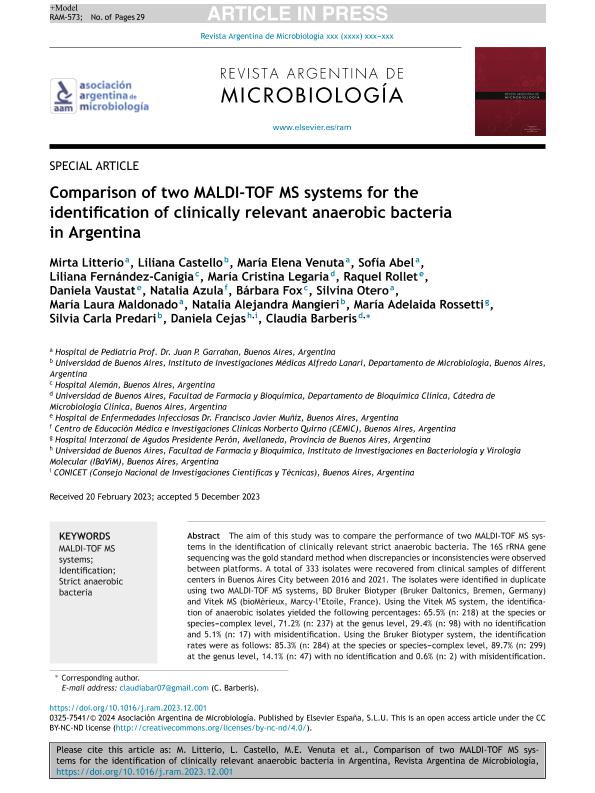Artículo
Comparison of two MALDI-TOF MS systems for the identification of clinically relevant anaerobic bacteria in Argentina
Título:
Comparación de dos sistemas MALDI-TOF MS en la identificación de bacterias anaerobias de relevancia clínica en Argentina
Litterio, Mirta; Castello, Liliana; Venuta, María Elena; Abel, Sofía; Fernández Canigia, Liliana; Legaria, María Cristina; Rollet, Raquel; Vaustat, Claudia Daniela; Azula, Natalia; Fox, Bárbara; Otero, Silvina; Maldonado, María Laura; Mangieri, Natalia Alejandra; Rossetti, María Adelaida; Predari, Silvia Carla; Cejas, Daniela ; Barberis, Claudia
; Barberis, Claudia
 ; Barberis, Claudia
; Barberis, Claudia
Fecha de publicación:
02/2024
Editorial:
Asociación Argentina de Microbiología
Revista:
Revista Argentina de Microbiología
ISSN:
0325-7541
e-ISSN:
1851-7617
Idioma:
Inglés
Tipo de recurso:
Artículo publicado
Clasificación temática:
Resumen
The aim of this study was to compare the performance of two MALDI-TOF MS systems in the identification of clinically relevant strict anaerobic bacteria. The 16S rRNA gene sequencing was the gold standard method when discrepancies or inconsistencies were observed between platforms. A total of 333 isolates were recovered from clinical samples of different centers in Buenos Aires City between 2016 and 2021. The isolates were identified in duplicate using two MALDI-TOF MS systems, BD Bruker Biotyper (Bruker Daltonics, Bremen, Germany) and Vitek MS (bioMèrieux, Marcy-l´Etoile, France). Using the Vitek MS system, the identification of anaerobic isolates yielded the following percentages: 65.5% (n: 218) at the species or species-complex level, 71.2% (n: 237) at the genus level, 29.4% (n: 98) with no identification and 5.1% (n: 17) with misidentification. Using the Bruker Biotyper system, the identification rates were as follows: 85.3% (n: 284) at the species or species-complex level, 89.7% (n: 299) at the genus level, 14.1% (n: 47) with no identification and 0.6% (n: 2) with misidentification. Differences in the performance of both methods were statistically significant (p-values <0.0001). In conclusion, MALDI-TOF MS systems speed up microbial identification and are particularly effective for slow-growing microorganisms, such as anaerobic bacteria, which are difficult to identify by traditional methods. In this study, the Bruker system showed greater accuracy than the Vitek system. In order to be truly effective, it is essential to update the databases of both systems by increasing the number of each main spectrum profile within the platforms.
Palabras clave:
MALDI-TOF MS
,
anaerobic bacteria
,
Argentina
Archivos asociados
Licencia
Identificadores
Colecciones
Articulos(OCA HOUSSAY)
Articulos de OFICINA DE COORDINACION ADMINISTRATIVA HOUSSAY
Articulos de OFICINA DE COORDINACION ADMINISTRATIVA HOUSSAY
Citación
Litterio, Mirta; Castello, Liliana; Venuta, María Elena; Abel, Sofía; Fernández Canigia, Liliana; et al.; Comparison of two MALDI-TOF MS systems for the identification of clinically relevant anaerobic bacteria in Argentina; Asociación Argentina de Microbiología; Revista Argentina de Microbiología; 56; 1; 2-2024; 33-61
Compartir
Altmétricas



